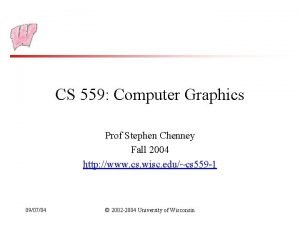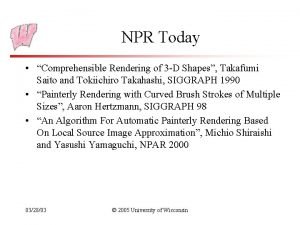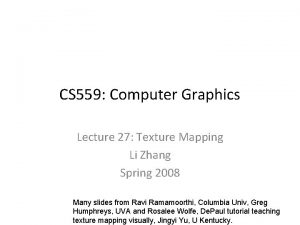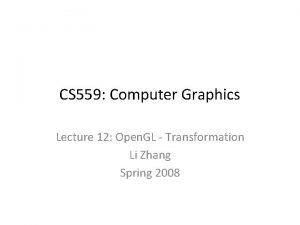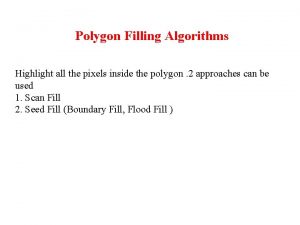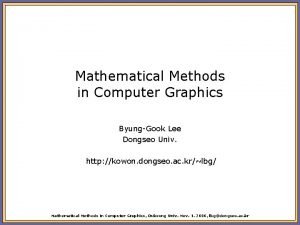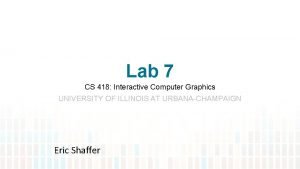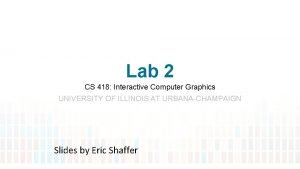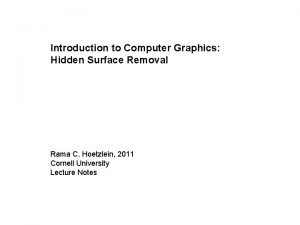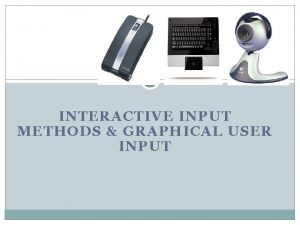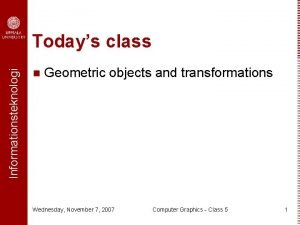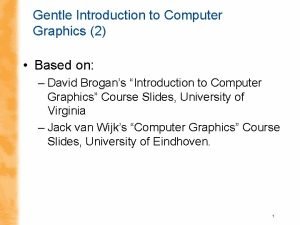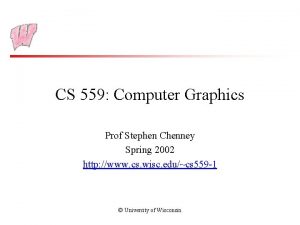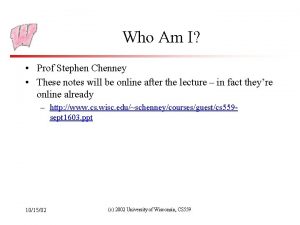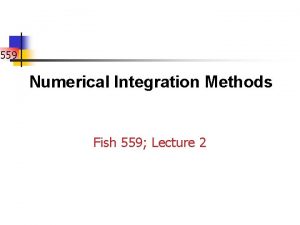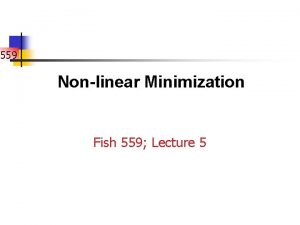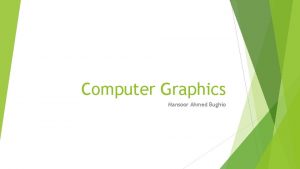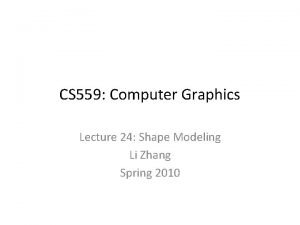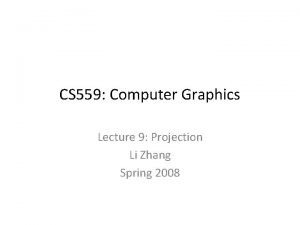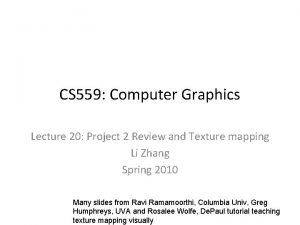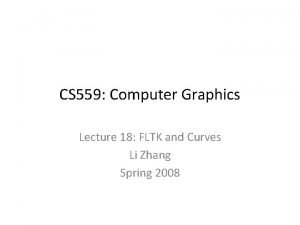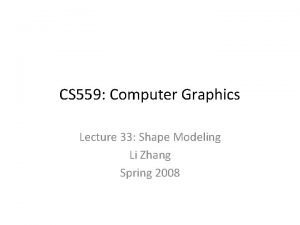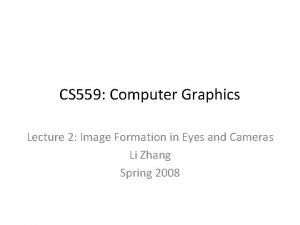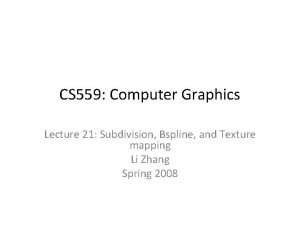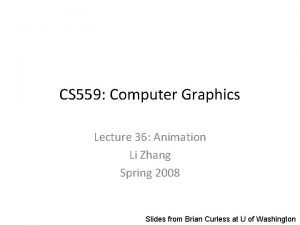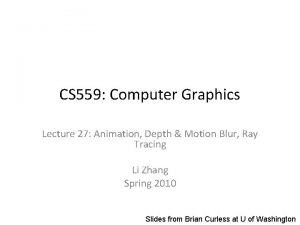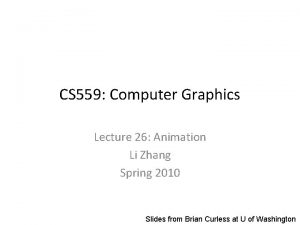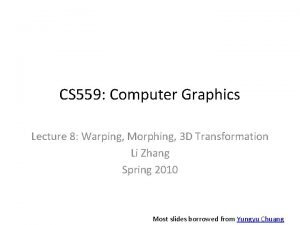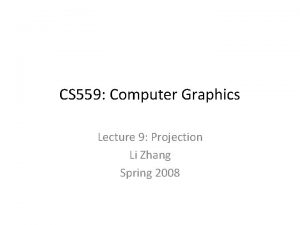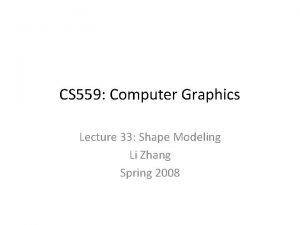CS 559 Computer Graphics Prof Stephen Chenney Fall




























- Slides: 28

CS 559: Computer Graphics Prof Stephen Chenney Fall 2004 http: //www. cs. wisc. edu/~cs 559 -1 09/07/04 © 2002 -2004 University of Wisconsin

Today • Course overview and information • Digital Images • Homework 1 – due Sept 14 in class 09/07/04 © 2002 -2004 University of Wisconsin

What is Computer Graphics? • Technically, it’s about the production, manipulation and display of images using computers • Practically, it’s about movies, games, design, training, art, advertising, communication, … 09/07/04 © 2002 -2004 University of Wisconsin

This Course: Building Blocks • Images and computers – Sampling, Color, Filters, … • Drawing in 2 D – Drawing lines and triangles, clipping, transformations • Drawing in 3 D – Viewing, transformations, lighting, real-time graphics • Modeling in 3 D – Describing volumes and surfaces, drawing them effectively • Miscellaneous topics – Raytracing, animation, … 09/07/04 © 2002 -2004 University of Wisconsin

People • Prof. Stephen Chenney – Room 6387 – Office Hours: TBD – schenney@cs. wisc. edu • TA: Leo Chao – Room 1346 – Office Hour TBD – chaol@cs. wisc. edu Send all class email to cs 559 -1@cs. wisc. edu It gets the fastest response. 09/07/04 © 2002 -2004 University of Wisconsin

Web and Email • The class web site is http: //www. cs. wisc. edu/~cs 559 -1 – – It is updated very frequently Lecture notes are put online before class, and updated after class Additional resources and links are provided Reading for future classes is listed • Email is sent out on the class mailing list – This list sends email to your official university email account • Check it regularly or set up forwarding – All notices are sent out on the mailing list, including things not mentioned in class – Only registered students get email • You read an archive at https: //www-auth. cs. wisc. edu/lists/classes/ 09/07/04 © 2002 -2004 University of Wisconsin

CS Computer Account • Everyone in the class needs a Computer Science department computer account – For completing and submitting projects • If you don’t have one, go to the CSL on the 2 nd floor • CS 559 provides you with a Windows account – You will only have a Unix account if you are taking some other course 09/07/04 © 2002 -2004 University of Wisconsin

Textbooks and Readings • Peter Shirley, “Fundamentals of Computer Graphics”, A. K. Peters, 2002 • Woo et. al. , "Open. GL Programming Guide", Third or Fourth Edition, Adison-Wesley, 1999 or 2003 – The definitive guide to Open. GL, and a reasonable description of general real-time 3 D graphics – It doesn’t really matter which edition – the differences are not pertinent to this class • Class readings – Online via the library’s reserve system – see class web page – A collection of papers, textbook chapters, and other documents – Some essential material not contained in the textbook 09/07/04 © 2002 -2004 University of Wisconsin

Projects • There will be three projects for the course, spread evenly through the semester • Project 1: Image editing • Project 2: Running a maze • Project 3: Building a virtual theme park • You must submit all three in order to pass the course – This rule has never been waived 09/07/04 © 2002 -2004 University of Wisconsin

Homeworks • There will be a homework every two weeks or so • They are intended primarily to explore topics further and to prepare you for the exams • They will be graded, but only the best five will count • Some essential techniques will be presented only in homework – For example, an review of linear algebra 09/07/04 © 2002 -2004 University of Wisconsin

Grading (approximate) • • • 45% Midterm and Final 45% Projects 10% Homework Everyone must write up their own homework For projects 1 and 3, you have the option of working in pairs 09/07/04 © 2002 -2004 University of Wisconsin

Lab Facilities • Room B 240 contains machines for use in this class • They have adequate hardware (circa 2001) and the software to make it work • Students in CS 559 have priority in the lab • There are benefits to working in a lab with your classmates – For instance, the blackboards frequently display useful hints that someone else scrawled – But they also sometimes have incorrect information!! 09/07/04 © 2002 -2004 University of Wisconsin

Software Infrastructure • FLTK will be the user interface toolkit – Provides windows, buttons, menus, etc – C++ class library, completely portable – We are currently at version 1. 1. 0 rc 6, available for free: www. fltk. org • Open. GL will be the 3 D rendering toolkit – Provides an API for drawing objects specified in 3 D – Included as part of Windows and in most Unix distributions • Although getting hardware acceleration may take some doing • Visual Studio. NET (Visual C++ 7. 1) will be the programming environment for grading • To be graded, your projects must compile under Visual C++ on the machines in room B 240 09/07/04 © 2002 -2004 University of Wisconsin

C++ • This is probably the first, and only, class in which you must complete large software projects in C++ without step by step instructions • There is a great deal of freedom in the projects, which requires that you do your own software design • If you are not comfortable in C++, you will have to take action • There are tutorials intended to teach you C++ assuming you know Java: – http: //www. cs. wisc. edu/~hasti/cs 368/Cpp. Tutorial/index. html – These are intended for the course CS 368, but just do the tutorials • The transition to C++ was one of the biggest issues for past CS 559 students – Visual Studio also causes issues – we will provide a transition tutorial 09/07/04 © 2002 -2004 University of Wisconsin

Adding the Class • Everyone should be able to add at this point • If not, email cs 559 -1@cs. wisc. edu with your name, ID and major – If the system gave you a reason for denying registration, include it in your email • You have to wait a couple of days after adding before you can get a CS computer account 09/07/04 © 2002 -2004 University of Wisconsin

Admin Questions? 09/07/04 © 2002 -2004 University of Wisconsin

Images • An image for our purposes is an abstract concept – It has no existence until it is displayed • An image is intended to describe the light that arrives at your eyes when you view it – You can be even more abstract: image describes what you should think when you see it • Different display devices convey the image content in different ways – e. g. Print and computer monitors use two fundamentally different approaches – The same image may look different on different monitors • Who cares? 09/07/04 © 2002 -2004 University of Wisconsin

Image Formats • We are familiar with many forms of image: – – – Photographs Paintings Sketches Television (NTSC, PAL-SECAM) Digital formats (JPEG, PNG, GIF, etc. ) • Each form has its own way of obtaining and storing the information content • We are primarily concerned with digital formats, but we will also discuss NTSC 09/07/04 © 2002 -2004 University of Wisconsin

Digital Images • Many formats (100 s) exist for storing images on a computer • There are some conflicting goals: – The storage cost should be minimized – The amount of information stored should be maximized • The size of something and the amount of information is contains are not the same thing – Original information versus perceptual equivalence – Tracking ownership may be important • Most formats you are familiar with are raster images 09/07/04 © 2002 -2004 University of Wisconsin

Raster Images • A raster is a regular grid of pixels (picture elements) • Raster image formats store the color at each pixel, and maybe some other information – Easiest is to use a simple array of pixel values – Some formats store the pixel information in very different ways – e. g. a 5 x 3, floating point, grayscale image 0. 25 0. 25 1 0. 25 09/07/04 © 2002 -2004 University of Wisconsin

Vector Images • Vector formats offer an alternative way to store images • The most common use of vector formats are in fonts – images of characters (Postscript, True. Type) • Store images as collections of geometric primitives – E. g. Lines, polygons, circles, curves, … • It is possible to go from a vector image to a raster image – We’ll learn how • It is very hard to go the other way 09/07/04 © 2002 -2004 University of Wisconsin

Trade-Offs • Which format, raster or vector, is easier to: – – 09/07/04 Display? Resize (scale bigger or smaller)? Rotate? Crop (cut bits off at the edges)? © 2002 -2004 University of Wisconsin

Obtaining Digital Images • What are some methods for obtaining a digital image? – – – – 09/07/04 Digital camera Scanning another image Other forms of scanning (eg medical) Editing existing digital images Paint or drawing programs Created from abstract data (e. g. math function plot) Rendered from a scene description … © 2002 -2004 University of Wisconsin

Ideal Images • The information stored in images is often continuous in nature • For example, consider the ideal photograph: – It captures the intensity of light at a particular set of points coming from a particular set of directions (it’s called irradiance) – The intensity of light arriving at the camera can be any positive real number, and it mostly varies smoothly over space – Where do you see spatial discontinuities in a photograph? Film Focal point 09/07/04 © 2002 -2004 University of Wisconsin

Digital Images • Computers work with discrete pieces of information • How do we digitize a continuous image? – Break the continuous space into small areas, pixels – Use a single value for each pixel - the pixel value (no color, yet) – No longer continuous in space or intensity • This process is fraught with danger, as we shall see Continuous Discrete Pixels: Picture Elements 09/07/04 © 2002 -2004 University of Wisconsin

Discretization Issues • Can only store a finite number of pixels – Choose your target physical image size, choose your resolution (pixels per inch, or dots per inch, dpi), determine width/height necessary – Storage space goes up with square of resolution • 600 dpi has 4× more pixels than 300 dpi • Can only store a finite range of intensity values – Typically referred to as depth - number of bits per pixel • Directly related to the number of colors available and typically little choice • Most common depth is 8, but also sometimes see 16 for grey – Also concerned with the minimum and maximum intensity – dynamic range • What is enough resolution and enough depth? 09/07/04 © 2002 -2004 University of Wisconsin

Perceptual Issues • Spatially, humans can discriminate about ½ a minute of arc – At fovea, so only in center of view, 20/20 vision – At 0. 5 m, about 0. 1 mm (“Dot pitch” of monitors) – Sometimes limits the required number of pixels • Humans can discriminate about 8 bits of intensity 129 128 125 – “Just Noticeable Difference” experiments – Limits the required depth for typical dynamic ranges – Actually, it’s 9 -10 bits, but 8 is far more convenient • BUT, when manipulating images much higher resolution may be required 09/07/04 © 2002 -2004 University of Wisconsin

Next Time • Color 09/07/04 © 2002 -2004 University of Wisconsin
 Chenney university
Chenney university Most of the graphics monitors today operate as
Most of the graphics monitors today operate as 3d viewing devices in computer graphics ppt
3d viewing devices in computer graphics ppt Ee 559
Ee 559 Cs 559
Cs 559 Cs 559 uw madison
Cs 559 uw madison Cs 559
Cs 559 G&l
G&l Angel computer graphics
Angel computer graphics Projection types in computer graphics
Projection types in computer graphics Types of display devices in computer graphics
Types of display devices in computer graphics Interior and exterior clipping in computer graphics
Interior and exterior clipping in computer graphics Shear transformation in computer graphics
Shear transformation in computer graphics Acos glsl
Acos glsl Scan conversation
Scan conversation Rigid body transformation in computer graphics
Rigid body transformation in computer graphics Flood fill algorithm are used to fill the
Flood fill algorithm are used to fill the Advantages and disadvantages of boundary fill algorithm
Advantages and disadvantages of boundary fill algorithm Polygon fill algorithm in computer graphics
Polygon fill algorithm in computer graphics The raster scan display the frame buffer holds
The raster scan display the frame buffer holds Computer graphics
Computer graphics Line drawing algorithm computer graphics
Line drawing algorithm computer graphics Cs 418 interactive computer graphics
Cs 418 interactive computer graphics Glcreatebuffer
Glcreatebuffer Hidden surface removal adalah
Hidden surface removal adalah Achromatic light in computer graphics
Achromatic light in computer graphics Interactive input devices
Interactive input devices Uniform scaling in computer graphics
Uniform scaling in computer graphics Uniform scaling in computer graphics
Uniform scaling in computer graphics




